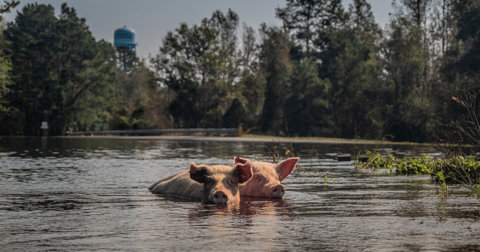Solutions
A New Wildlife Crossing Provides Safe Passage Over a Busy Interstate
Climate•8 min read
Reported
Millions of animals die in floods and wildfires each year. Should factory farms be required to have a relocation plan?


Words by Jessica Scott-Reid
The fall of 2021 was particularly brutal for British Columbia. The Canadian province was hit hard by devastating floods and landslides, forcing the evacuation of more than 15,000 people. By early December as clean-up began, government officials estimated that farmers left hundreds of thousands of farm animals behind to die: 12,000 hogs, 420 dairy cows and over 600,000 chickens in total, in addition to millions of honeybees.
These types of climate disasters used to be exceptional. But according to the most recent U.S. national climate assessment, the country experienced only around three billion-dollar disasters per year during the 1980s. Four decades later in 2022, there were 18 in just that single year alone. Governments are investing in climate disaster preparedness, but there is one population consistently left out of evacuation plans: farm animals.
The pattern is unmistakable. News stories describe massive sheds packed with animals flooded or consumed by fire, leading to millions of deaths, but most of these media accounts fail to ask what might happen next time. That’s no accidental omission. In the U.S., Canada and the UK, there are no laws requiring farm animals to be relocated before disaster strikes. It’s just too expensive, say the agricultural economists who spoke with Sentient Media. And even though a new bill pending before Congress could change the incentive structure, it’s not clear whether the outcome would be better.
Most industrial-scale factory farms are packed to the brim with animals. According to the British Columbia Chicken Marketing Board, the average number of chickens held per barn in the region is 50,000, for instance. “There is no current limit on the number of animals that can be housed on farms in Canada,” read a statement from Canadian animal protection organization Animal Justice in 2021.
Dealing with that many animals in a natural disaster is practically impossible, and there are no legal welfare protections in place for those scenarios. There are “no regulations setting out welfare standards for farmed animals or requiring an evacuation plan,” according to Animal Justice.
In a nutshell, it’s a financial decision for farmers. “The cost of relocating livestock is affected by a number of factors,” explains David Ortega, an associate professor at Michigan State University in the Department of Agricultural, Food and Resource Economics, “including the animals’ weight and size, distance traveled, time of year, diesel prices and the cost of insuring the livestock during transportation.”
Moving that many animals on short notice is expensive. “This can all add up very quickly and be very costly for producers, who are already operating under tight margins,” says Ortega. Expect surge pricing too. When it comes to relocating animals in an event of extreme weather or other types of disasters, Ortega says, “there would be a surge in demand for transportation and hauling services, which would further increase the costs during those periods, making this a very challenging option.”
Farmers weigh the cost of relocating animals against the cost of leaving them behind, but there’s also another factor — the insurance plan. The financial loss resulting from leaving animals behind to die is typically subsidized by governments, or paid out by private insurance.
“Substantial compensation for livestock losses in disasters (including some disease outbreaks) is provided by the U.S. government through both standing programs and ad hoc interventions,” explains Jim Leitzel, a professor of economics and public policy at the University of Chicago.
These payouts may be incentivizing producers to leave their animals behind. “When faced with a looming disaster, animal owners and contract farmers — both are eligible for compensation — have limited financial incentive to take costly measures to save their animals.”
What’s more, there’s little economic benefit to arranging and paying for rescue. “Compensation is generally not linked to prevention efforts,” says Leitzel. In other words, it doesn’t pay to rescue or relocate. It’s cheaper to leave them behind.
But as climate disasters increase, so does the cost of compensating farmers. The U.S. Department of Agriculture has an initiative called the Livestock Indemnity Program, which compensates producers for farm animals lost due to extreme weather events.
The program’s payments are equivalent to 75 percent of the average fair market value of the livestock. According to public records obtained by the Animal Welfare Institute (AWI) through a freedom of information act request, the USDA distributed nearly $47 million during fiscal year 2022, money spent to compensate for 350,000 farm animals killed.
Relocating animals ahead of disaster “is not impossible,” says Animal Welfare Institute’s Allie Granger. “It just requires significant coordination and commitment.” In 2018 during Hurricane Florence in North Carolina, tens of thousands of animals were, in fact, moved. Even though millions of animals perished, “the North Carolina Pork Council touted the work of their members in relocating over 20,000 pigs.”
That effort was entirely voluntary, however. There’s no legal requirement to relocate or rescue farm animals. Facilities regulated under the Animal Welfare Act, such as zoos and some research labs, are required to have emergency plans, but farms are exempt.
“Producers are not required to demonstrate they took any steps to protect their animals or mitigate losses prior to receiving taxpayer-funded assistance,” says Granger, of the current regulatory framework.
Campaigners with the Animal Welfare Institute are advocating for the Emergency and Disaster Preparedness for Farm Animals Act (HR 243), introduced to Congress by Rep. Steve Cohen (D-TN) last January. If it were to pass, the bill would require producers to have disaster assistance plans in place, in order to be eligible for certain USDA assistance programs.
Delcianna Winders, an associate professor of law and director of the Animal Law and Policy Institute at Vermont Law School calls the bill a step in the right direction. For now, she says, “Massive subsidies to industrial animal agriculture disincentives protecting animals during severe weather events,” Winders says, which leaves “millions to suffer and die every year.” This bill, she says, would at least require farmers to make some demonstration of preparedness, which could help to remove some of that incentive.
That said, there’s no language in the bill to ensure the “plan” wouldn’t just be mass culling, or “depopulation” as the industry sometimes calls it, using a method critics say causes massive animal suffering, like ventilation shutdown to induce heatstroke.
More transparency around disaster preparedness would help, says Winders. If the agency made plans for factory farms public, there would be “some accountability and assurance that the plans are meaningful, and not just window dressing.”
At least for now however, the proposed bill does not include that kind of detail. The language does not lay out exactly, or even vaguely, what those disaster preparedness plans would be required to include. However, says Winders, “It’s not unusual for a statute to be light on details about requirements, and to instead defer to an agency to develop them like this bill does.”
Unfortunately, the bill’s chances for passing are slim, at least according to Winders. Still, leaving out specifics about rescue might at least give it a better chance, says Granger. And getting something passed now is critical, she argues, as we brace for climate disasters to become more regular throughout the year.
For now, even though Congress has recognized that millions of farm animals die in these climate disasters, and lawmakers have directed the USDA to work with producers who do want to develop disaster plans, there is no legal requirement to ensure producers at least try to relocate. Ultimately, says Granger, “it is unclear what actions the USDA is taking to ensure farms have contingency plans in place for natural disasters,” and whether those plans include evacuating or relocating farm animals.
In Canada, there are no laws and no pending legislation that would protect or prepare farm animals ahead of climate disaster. Canadian officials published an Emergency Preparedness for Farm Animals brochure in 2011, but the plan is guidance, not a requirement.
The bottom line, for Winders: “We should of course rethink bankrolling an industry that majorly contributes to climate change,” she says. But if governments are going to continue to subsidize factory farms, the least we can do is remove the incentive to leave animals behind, and “require some effort to protect them.”